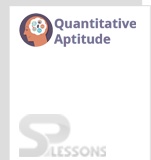 Introduction
Introduction
What is Quantitative Aptitude test?
Quantitative Aptitude is one of the prominent competitive aptitude subjects which evaluates numerical ability and problem solving skills of candidates. This test forms the major part of a number of important entrance and recruitment exams for different fields. The Quantitative Aptitude section primarily has questions related to the Simplification, Numbering Series, and Compound Interest, etc.
A candidate with quantitative aptitude knowledge will be in a better position to analyse and make sense of the given data. Quantitative Aptitude knowledge is an important measure for a prospective business executive's abilities.
The article SSC CPO Quantitative Aptitude Quiz 5 provides Quantitative Aptitude questions with answers useful to the candidates preparing for Competitive exams, Entrance exams, Interviews etc. The article SSC CPO Quantitative Aptitude Quiz 5 will assist the students to know the expected questions from Quantitative Aptitude.
 Quiz
Quiz
1. A sum fetched a total simple interest of Rs. 4016.25 at the rate of 9 p.c.p.a. in 5 years. What is the sum?
- A. Rs. 4462.50
B. Rs. 8032.50
C. Rs. 8900
D. Rs. 8925
E. None of these
- A. 49 m[latex]^{2}[/latex]
B. 50 m[latex]^{2}[/latex]
C. 53.5 m[latex]^{2}[/latex]
D. 55 m[latex]^{2}[/latex]
- A. [latex]\frac {699}{301}[/latex]
B. [latex]\frac {1000}{301}[/latex]
C. 0.3010
D. 0.6990
- A. 40 sec
B. 47 sec
C. 33 sec
D. None of these
- A. Rs. 1200
B. Rs. 2400
C. Rs. 4800
D. Cannot be determined
E. None of these
1. A man covered a certain distance at some speed. Had he moved 3 kmph faster, he would have taken 40 minutes less. If he had moved 2 kmph slower, he would have taken 40 minutes more. The distance (in km) is:
- A. 35
B. 36[latex]\frac {1}{3}[/latex]
C. 37[latex]\frac {1}{2}[/latex]
D. 40
- A. 10
B. 11
C. 13
D. 15
- A. 1260
B. 1140
C. 2580
D. 3200
- A. –[latex]\frac {1}{11}[/latex]
B. – [latex]\frac {11}{121}[/latex]
C. [latex]\frac {1}{122}[/latex]
D. [latex]\frac {121}{11}[/latex]
- A. 6 hrs
B. 7 hrs
C. 8 hrs
D. 14 hrs
1. If log 2 = 0.30103, the number of digits in 2[latex]^{64}[/latex] is:
- A. 18
B. 19
C. 20
D. 21
- A. 100m
B. 80m
C. 90m
D. 110m
- A. 20
B. 30
C. 40
D. 50
- A. 3
B. 6
C. 24
D. 120
E. 12
- A. x[latex]^{abc}[/latex]
B. 1
C. x[latex]^{ab + bc + ca}[/latex]
D. x[latex]^{a + b + c}[/latex]





